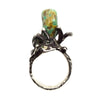
Loloma, Charles (1921-1991) Biography
Loloma was a leader in modern Native jewelry design whose innovations made him the most famous and widely collected Indian jeweler of all time. He was born near Hotevilla on Hopi’s Third Mesa and attended Hopi High School where Fred Kabotie led the art program.
In 1939, Kabotie asked Loloma to assist him in creating murals for the Golden Gate Exposition in San Francisco and the next year with a mural commission for the Museum of Modern Art in New York. Loloma served in the US Army from 1941 to 1945, and shortly after discharge he enrolled in the School for American Craftsmen at Alfred University in New York on the GI Bill.
In 1949 he received a fellowship from the Whitney Foundation to study Hopi ceramics, and in 1954 he moved to Arizona and opened a ceramics studio in Lloyd Kiva New’s Kiva Crafts Center in Scottsdale.
Loloma started making jewelry around 1955 and gradually abandoned his Lolomaware line of pottery. By the 1960s he had earned an international reputation for innovative jewelry using sandcasting, fabricated silver or gold, and a variety of stones and other materials including ironwood and fossilized bone and ivory.
Loloma taught at both the University of Arizona and Arizona State and served on many boards and committees in the field of art and craft. He received many commissions from famous clients and from the US State Department as gifts for the wives of foreign dignitaries.
Although Loloma was a celebrity in the world of Native arts, he maintained a studio near Hotevilla all of his life and participated in the religious life of the village.
